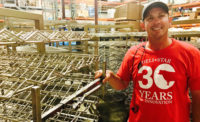Meat processors have always had to work harder than other industries to keep their employees safe. After all, when you have a processing floor full of processing machinery and knives, you have more inherent danger than, say, an accounting firm.
The industry has worked to improve worker safety, but the Coronavirus has brought a new threat that the industry, not to mention the country, was not prepared to handle. The number of plant closures, mass outbreaks in plants and supply chain disruptions gave evidence to that.
“Essentially, each processor and manufacturer had to establish a new culture of health and safety within their organization against the backdrop of evolving science on SARS-CoV-2 controls, inconsistent federal, state and local jurisdiction guidance, and critical supply chain shortages of PPE and sanitation supplies,” said Laura Dunn Nelson, VP Food Safety and Global Alliances, Intertek Alchemy.
The smaller processors, with fewer employees and more flexibility, were better suited to enact social distancing policies more quickly than the larger plants. Over the course of a year, the industry as a whole worked to get the COVID pandemic under control and enact safety procedures that kept the workforce as safe as possible.
Data from the Food and Environment Reporting Network (FERN) noted that the meat and poultry sector was reported to have an average of 19.91 new reported cases per 100,000 workers per day in December, compared to an average of 98.39 new reported cases per 100,000 workers per day in May. This 2020 data notes that reported new COVID-19 infection rates amongst meat and poultry workers were five times lower in December than in May, while rates in the general population rocketed up by nine times in the same period, as noted by the North American Meat Institute.
“This certainly speaks to the continued vigilance the meat and poultry industry has exhibited in executing their health and safety protocols to protect their workforce,” Dunn Nelson adds.
After a year of dealing with COVID-19, many people are longing for a return to normal. That is not like to happen, explains Steve Robert, Global Vice-President, Sales/Marketing and Product Innovation, AIB International. He points out that the World Economic Forum notes that “COVID-19 is the sixth global health crisis since the flu pandemic of 1918.” They also estimate that there are up to 827,000 “undiscovered” viruses in mammals and birds that could infect humans.
“As a result, we believe there is now an urgency for operations leadership to do everything they can to mitigate the impacts of current and future pandemic events by elevating their critical planning and establishing industry-recognized best practices for supporting food safety, employee health and business continuity,” he says.
In short, we will recover from COVID-19, but what about the next pandemic? The level of preparedness that companies had to establish may become standard operating procedure in the future. At the very least, companies may need to be ready to jump back into pandemic protocols at a moment’s notice. Certification for preparedness could become a requirement in the future, as they are currently for food safety or animal welfare.
“Long term, those operations should be committed to maintaining those best practices, actively assessing risk management protocols, and continuously refining their plan to remain certified to the standard. Operations that do so will be recognized as bringing the highest standards of integrity to the global food and beverage supply chain,” says Robert. AIB has established a Pandemic Prepared Certification, which requires proficiency in several key areas, including Supply Chain Management and Health Crisis Mitigation Measures and Management.
Similarly, Alchemy is launching a training course to establish an infectious disease plan, Dunn Nelson says, leveraging the actual experiences and established best practices of many of the food industry’s current pandemic coordinators.
“In addition to training, it’s always a best practice to review your company’s response/plan to the COVID-19 pandemic and adjust your plan accordingly. What is going well? Where were the biggest challenges and opportunities for improvement?” she advises. “Many companies found their associations to be invaluable in helping to identify new resources and to navigate the evolving scientific guidance. Companies should make a concerted effort to maintain these channels of communication, along with their increased communications with city, state and federal regulators, their legal teams, scientific experts, new supply chain suppliers and other subject matter experts so that these resources and contacts stay current when needed in the future.” IP










